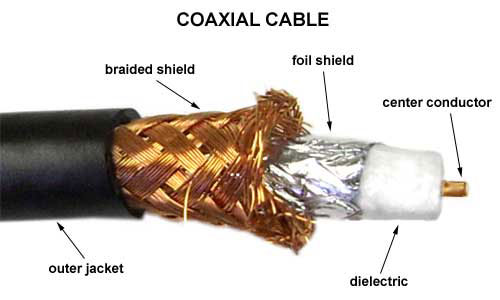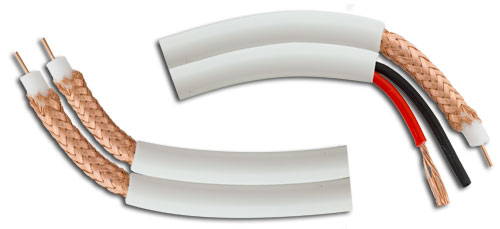Coaxial Corner
Most of us are familiar with coaxial cable being commonly used for cable TV and satellite installations, but it is also used in a variety of other applications. Some of these applications are CCTV (Closed Circuit Television), audio, video, musical interconnects, radio antenna, computer network connections (Cable modems), etc.
What is a coaxial cable? To refresh your memory, or to make you just a little more familiar with what makes a coaxial cable, we'll open one up and take a better look. Coaxial cable has five key components, which you will find listed and illustrated below. (You can refer to the article " Coaxial Cables " for more detail on each component.)
- Center Conductor (Bare Copper or Copper Coated) (Solid or Stranded)
- Dielectric Insulator
- Foil Shield
- Braided Shield (Aluminum or Copper)
- Outer Jacket

In geometry, the term coaxial means that two or more forms share a common axis. In the case of coaxial cable it is when the inner conductor and the outer shield share the same geometric axis. In the illustration below the x and y axes are shown, the point where they meet is the z axis. Note how both the outer shield and the inner conductor share the z axis as a center point.

Coaxial cable is the most common cable used as a transmission line, transmitting electrical energy or signal from one place to another. It comes in a large variety, typically identified by impedance and/or RG-type. RG (Radio Guide) is a generic term (WWII United States military specifications) that is used to identify a large variety of cable designs. It is commonly followed by a number.
The more commonly used RG-types are RG6 and RG59. These two types are commonly used in Cable TV, satellite and CCTV applications. Both have an impedance of 75 ohms, a characteristic common to video and audio equipment for its low attenuation.
RG59 is a single shielded coaxial cable about 6.1 mm in diameter with a smaller center conductor than your standard RG6 cable. Although RG59 can be used for cable TV applications (CATV), there is a significant amount of signal loss over higher frequencies when run at longer distances. RG59 is typically used to carry baseband video in CCTV applications.
Today RG6 is the more commonly used RG-type. RG6 is used in a variety of applications, both residential and commercial. RG6 is typically a double shielded coaxial cable about 6.86mm in diameter with a center conductor a bit larger than that of the RG59 type. RG6 is commonly used in Cable TV, Satellite TV and Cable Modem applications due to its low attenuation over high frequencies.
Both RG6 and RG59 come in a variety of types, which are all designed for specific applications. Below is a list of eight commonly used coaxial designs for a typical video distribution application:
-

- Flooded/Direct Burial: Flooded/ Direct Burial coaxial cable is designed for installation inside underground conduits. It is used in cable TV applications as a transmission line from the signal source to the customer's home. Some flooded cable contains a sticky gel-like substance for heavier waterproofing.
-

- Indoor/Outdoor: Indoor/ Outdoor (Interior/Exterior) coaxial cable is not based on any specific RG type, it is a basic coaxial cable. Jacket ratings differentiate the two. White is usually chosen as interior coaxial cable due to the fact that most homes or dwellings will use white trim around the base of the floor. This design is primarily based on aesthetics, and is solely a customer's preference. Black coaxial cable will also work for interior installations. Black is often used in an interior space when run between walls of a single dwelling home or an apartment building. Black is also used outdoors primarily for aesthetics. When installed underneath the eve on the exterior wall of a single dwelling home, black tends to be less visible. Coaxial cable designed for outdoor use will also have a (UV) rated jacket for protection against sun exposure.
- Plenum: Plenum rated (CMP) coaxial cable comes in a variety of RG types but is differentiated by its outer jacket. Plenum rated coaxial cable is designed using a special Teflon material for the outer jacket. This cable is required for runs involving ventilation ducts and is designed to meet fire codes.
- Riser: Riser rated (CMR) coaxial cable comes in a variety of RG types and is used in vertical tray applications when installing between floors through cable risers or in elevator shafts. It is for non-plenum spaces.
- RG11: RG11 is a triple or quad shielded coaxial cable about 10.5 mm in diameter and is used for long runs, in both aerial and underground conduit. RG11 coax operates at an impedance of 75 ohms and is suitable for video distribution. It finds additional usage in cable TV installations where the distance from the TAP splitter to the customer's home is longer than 250 ft in length. RG11 is a lot thicker than your RG6 and RG59 types and has a larger center conductor allowing for low attenuation at longer distances.
-

Coaxial cable has a plethora of connectors for termination. As was briefly explained earlier in the article, coaxial cable is a multi purpose cable used in a number of applications. Connectors come in many different types and sizes relative to each coaxial series. Some of the more common coaxial terminations are F-pin and BNC. Both F-pin and BNC connectors are referred to as RF (Radio Frequency) connectors and operate at impedance of 75 ohms. F-pin connectors are found in cable TV, Satellite TV and cable modem installations. BNC connectors are used in closed circuit television/surveillance camera, networking and HDSDI (High Definition Serial Digital Interface) applications. Both F-pin and BNC connectors can be found in a variety of termination types (crimp-on, twist-on, solder, or compression). Another well-known connector type used to terminate coaxial cable is the RCA connector. The RCA connector, also known as a phono connector, is commonly used to carry audio and or video signals from a variety of musical equipment and audio/visual hardware. (Televisions, cable boxes, mixers, audio receivers, speakers, amplifiers, etc.). You can refer to our previous article " Coaxial Cables " for further detail on the connectors mentioned in this article.

Coaxial cable uses include a variety of hardware and adapters. Some of the more common pieces of equipment used in conjunction with some of the more common coaxial designs are passive devices such as splitters, F-pin couplers (Barrels), Diplexers, etc.
Coaxial cable is like the Swiss Army knife of cables. Its many personalities allow it to adapt and be applicable to today's society and its needs. It will remain relevant for the foreseeable future due to its low cost and ability to transmit high quality signal. I hope that we have been able to answer many of your questions on the subject of coaxial cable.






